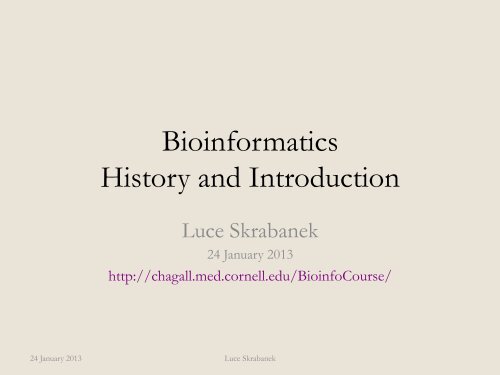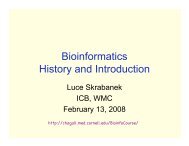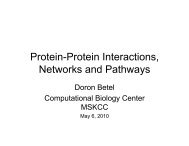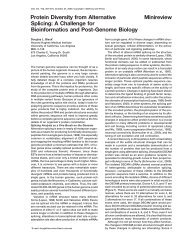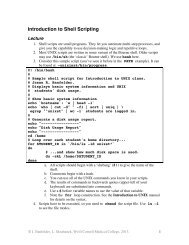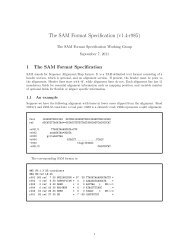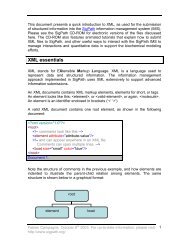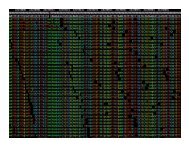Bioinformatics History and Introduction - Chagall
Bioinformatics History and Introduction - Chagall
Bioinformatics History and Introduction - Chagall
Create successful ePaper yourself
Turn your PDF publications into a flip-book with our unique Google optimized e-Paper software.
<strong>Bioinformatics</strong><strong>History</strong> <strong>and</strong> <strong>Introduction</strong>Luce Skrabanek24 January 2013http://chagall.med.cornell.edu/BioinfoCourse/24 January 2013 Luce Skrabanek
What is bioinformatics?• The application of statistics <strong>and</strong> computerscience to the field of molecular biology• Uses computers to store, manage, manipulate,analyze biological data• Applications:– Unravel biological meaning <strong>and</strong> develop biological<strong>and</strong> evolutionary insights– Drug discovery <strong>and</strong> development; personalizedmedicine24 January 2013 Luce Skrabanek
Required skills• Biology• Computer science• Mathematics/Statistics• Information technology• All needed to some degree but some needed morefor some applications than others• Often, not all required skills are present in oneperson. Need teams with programmer, biologist, ITperson, statistician, even graphic designer24 January 2013 Luce Skrabanek
<strong>Bioinformatics</strong> is predictive• Runs the gamut of predictive capability• Prediction is based on what we already know (i.e.,biological knowledge)– What is the function of a protein?– How does a protein function?– What factors does a protein need to function?– How do multiple proteins interact with one another <strong>and</strong>affect each other’s function?• <strong>Bioinformatics</strong> does not replace experiments24 January 2013 Luce Skrabanek
Applications of bioinformatics• Most basic: use web-based tools– Primarily need biology• Use Unix-based tools– Above, plus need ability to use Unix, write wrappers in Perl/Python, write shell scripts• Use Unix tools for high-throughput data– Above, plus an underst<strong>and</strong>ing of data storage <strong>and</strong> scalability• Algorithm development– Computer-science focus, will usually partner with a biologist• Making data/methods public– Creating databases/web pages (IT)24 January 2013 Luce Skrabanek
Interplay of disciplines• Advances in experimental biology give us new<strong>and</strong> different types of data to analyze, which mayrequire completely new ways of dealing with thatdata (e.g., data from high-throughput experiments)• Advances in biological underst<strong>and</strong>ing allowcomputational predictive models to incorporatemore information <strong>and</strong> become more complex• Advances in computer technology allow us to dealwith greater amounts of data in reasonable timeframes24 January 2013 Luce Skrabanek
The scales of knowledge• Historically, dealing with one protein at a time• Nowadays, we are dealing with large amounts ofnoisy data – requires a new kind of scientist: “datascientist”– Translates data into predictive insights– Feels comfortable dealing with noisy incomplete data– Explores data to generate hypotheses, exploration drivesdirection of research– Can h<strong>and</strong>le the challenge of dealing with petabytes ofdata24 January 2013 Luce Skrabanek
Scalability• Huge volumes of data available to us– Complete genomes, NGS• Necessary computational resources now available to dealwith these amounts of data– 8 GB (~human genome) can be stored on an iPod– Tree of life can be stored in 1TB– Raw data from 1 NGS experiment = 1TB• Tools <strong>and</strong> techniques have to be efficient <strong>and</strong> scalable24 January 2013 Luce Skrabanek
Biology of Systems• Huge amounts of ‘parts’ data– Sequence (both nucleotide <strong>and</strong> protein)– Structure– Function– Biochemical information– Protein-protein interactions, complexes– Protein-DNA complexes– Kinetics of reactions Integrated together into “Systems Biology”• The study of the interactions between the components of a biologicalsystem• How do those interactions give rise to the functions <strong>and</strong> behaviors thatwe see?24 January 2013 Luce Skrabanek
Mathematical modeling• Biological systems can be represented by ODEs– compartments– stochastic methods for low concentration components• Systems modeling can:– effectively integrate “parts” information– help reveal non-intuitive “emergent” properties– teach us how cells store information <strong>and</strong> ‘compute’• Quantitative models of pathways <strong>and</strong> networks– predict cellular responses to external stimuli– model effects of perturbations on the system– predict how to ‘correct’ disease states• identify control points in the system24 January 2013 Luce Skrabanek
24 January 2013 Luce SkrabanekRavi Iyengar lab
24 January 2013 Luce Skrabanek http://www.biocarta.com/pathfiles/h_mapkPathway.asp
Where do we get our data from?• Experimental data from collaborators• Databaseshttp://www.oxfordjournals.org/nar/database/c/24 January 2013 Luce Skrabanek
Some important databases• Archives of data stored in a uniform, consistent, efficient,searchable way (database <strong>and</strong> query tools)• Primary databases vs. secondary databases– Sequence <strong>and</strong> annotation vs. curated results of analyses• PubMed• GenBank/EBI/DDBJ vs. RefSeq• Short Reads Archive• UniProtKB• PDB• HPRD24 January 2013 Luce Skrabanek
Caution!• Errors in the databases– wrong positions of genes– exon-intron boundary errors– contaminating sequences– sequence discrepancies/variations– frameshift errors– annotation errors– spelling mistakes– incorrectly joined contigs24 January 2013 Luce Skrabanek
Mouse build 30Chr 15Chr 15_r<strong>and</strong>om24 January 2013 Luce Skrabanek
My protein doesn’t begin with an M?• Nuclear-encoded proteins always begin with amethionine• Some entries in protein databases don’t!– Some part of the 5’ UTR was misinterpreted ascoding sequence– mRNA was not fully sequenced at the 5’ end• In both cases, we can use comparative alignmentinformation, either from closely related paralogs or otherESTs/mRNA sequences to try to identify the correct genestructure24 January 2013 Luce Skrabanek
Consequences of errors in trusted data sources• Automated annotators (e.g., function, genome) relyon curated information sources to make predictions• False research directions, false conclusions– Willersley 2002 – contaminant misidentified as lateraltransfer from prokaryotes into humans; Sekyere 2003 –non-existent human melanotransferrin gene– deCODE overestimated genetic diversity in Icel<strong>and</strong>ersbecause of errors in mtDNA sequencing studies• Impediment to improving current predictionmodels– Harder to improve if we don’t know where the errors incurrent knowledge lie24 January 2013 Luce Skrabanek
Some sample error rates• GenBank: 0.29% - 3.1% sequencing errors– Wesche et al, DNA Seq 2004• Enzyme annotations: ~0% (SwissProt) – 5-63%(NR/TrEMBL/KEGG)– Schnoes et al, PLoS Comput Biol 2009• GO database (st<strong>and</strong>ard database used forautomated functional annotation prediction):28-30%– Jones et al, BMC Bioinfo 200724 January 2013 Luce Skrabanek
Methods of error introduction• Entry errors in primary databases– Direct deposit into database by experimentalists– Incorrect transfer (from literature, other databases)by curators• Analysis errors in secondary databases– Incorrectly derived data• Inherited errors in secondary databases– Sequence similarity based annotation strategies mayintroduce new annotation errors, by incorrectlyidentifying similar sequences24 January 2013 Luce Skrabanek
Propagation of errors• The quality of existing sequence annotationsimpacts on the quality of future sequenceannotations through the commonly used practice ofbasing sequence annotations on sequence similarity.• Corrections to such errors rarely occur, <strong>and</strong> whenthey do, the correction usually does not getpropagated.– Some exceptions: SwissProt/UniProtKB, a curateddatabase, does get regularly updated <strong>and</strong> correctedMORAL: as a submitter, quality check when enteringdata; as a user, keep possibility of errors in mind24 January 2013 Luce Skrabanek
Examining bioinformatics approaches to abiological problemmiRNA target prediction24 January 2013 Luce Skrabanek
miRNAs: an introduction• Small RNA molecules, 19-24 bases in length,that are involved in regulation of numerousbiological processes– Target mRNA for degradation– Repress translation• Derived from longer primary miRNA transcripts24 January 2013 Luce Skrabanek
<strong>Introduction</strong> contd.• First discovered in C. elegans in 1993– lin4, let7• Subsequently found to be widespread• About 1600+ human miRNAs known– Many have been associated with specific diseases• Identification of specific miRNA species may be a possible toolfor cancer diagnosis– TarBase – database of experimentally verified miRNAtargets– miRBase – database of published miRNA sequences <strong>and</strong>targets24 January 2013 Luce Skrabanek
miRNA3’ UTR24 January 2013 Luce Skrabanekadapted from Li et al, Mamm Genome 2009
Direct experimental identificationof target genes• Reporter constructs (luciferase, GTP) with the3’ UTR of the predicted target gene: measurechange in intensities after introduction of miRNA• RT-PCR: track changes in mRNA levels afterintroduction of miRNA• Does not directly identify MREs (miRNArecognition elements)– Site-directed mutagenesis studies– Restoration of complementarity by mutating miRNAsequence24 January 2013 Luce Skrabanek
Indirect experimental identification of targetgenes (target “enrichment”)• For miRNAs involved in RNA degradation– Microarrays: differential gene expression with/withoutmiRNA [secondary <strong>and</strong> non-specific effects]– RNA-Seq: next gen sequencing method of measuringdifferential expression [secondary <strong>and</strong> non-specific effects]– HITS-CLIP (high-throughput sequencing of RNAs isolatedby crosslinking immunoprecipitation): can identify specificbinding sites for targeted miRNAs [non-functional sites] [Chi et alNature 2009]• For miRNAs involved in translation repression– pSILAC (stable isotope labeling of amino acids in cellculture): differential protein expression levels [secondary <strong>and</strong> nonspecificeffects] [Baek et al Nature 2008; Selbach et al Nature 2008]24 January 2013 Luce Skrabanek
Computational prediction of miRNA targetsCanonicalDominant seedCompensatoryMain types of target site duplexMazière <strong>and</strong> Enright, Drug Disc Today, 200724 January 2013 Luce Skrabanek
Computational prediction of miRNA targets• Problems:– Short length: normal (Karlin-Altschul) alignmentstatistics no longer hold; even over the shortalignment length, can have bulges <strong>and</strong> loops– Not all 3’ UTRs characterized: critically important tohave the whole 3’ UTR• 30% of human genes lack definitive 3’ UTR boundaries– Unavailability of appropriate species forconservation analysis24 January 2013 Luce Skrabanek
Computational prediction of miRNA targets• Different trade-off between sensitivity <strong>and</strong>specificity depending on requirements– Large-scale genome studies often sacrifice sensitivityfor specificity – they want fewer false positives, atthe cost of more false negatives – to ensure (fewer)predictions of better quality– A researcher interested in a single gene or pathwaywho wants to know how miRNAs impact theirsystems may want to have a very high sensitivity (fewfalse negatives) because they will want to identify(<strong>and</strong> test) as many real regulation points as possible24 January 2013 Luce Skrabanek
Pipeline to identify miRNA targets inDrosophila - miR<strong>and</strong>a73 known Drosophila miRNAsEnright et al, Genome Biology, 2003Find complementary sequence matches in 3’ UTRs(Modified Smith-Waterman algorithm)Calculate free energy (stability) of miRNA/UTR binding(ΔG Kcal / mol)Estimate evolutionary conservation(Sequence conservation; relative positioning within the 3’ UTR)24 January 2013 Luce Skrabanek
Sequence matching: problems• miRNAs are very small (21-22nt)– Enormous number of potential targets withcomplementary sequence– BLAST does not scale.• Low-complexity sequences– Signal to noise problem• St<strong>and</strong>ard sequence analysis packages generally notapplicable– Looking for complementarity, not similarity• i.e. A:U G:C not A:A G:G etc.– Wobble pairing permitted• G:U <strong>and</strong> U:G base pairs• Small number of known cases to work with24 January 2013 Luce Skrabanek
Sequence matching algorithm• Modified Smith-Waterman algorithm– Instead of looking for matching nucleotides, findscomplementary nucleotides– Allows GU ‘wobble’ pairs (but downweights them)– Scoring system weighted so that complementarity to thefirst 11 bases of the miRNA is more greatly rewarded– Non-complementarity also more heavily penalized in thatregion– Known miRNAs bind 3’ UTRs at multiple sites• Additive scoring system for all target sites predicted in a UTR• Calculate free energy of binding (Vienna RNApackage)24 January 2013 Luce Skrabanek
Evolutionary conservation• Used conservation as a way of keeping only the mostlikely miRNA target c<strong>and</strong>idates• Used Drosophila pseudooscura <strong>and</strong> Anopheles gambiae asclosely related species:– Required ≥ 80% sequence similarity of target site withD. pseudooscura– Required ≥ 60% sequence identity with A. gambiae• Also, required that the location of the target site in the3’ UTR be equivalent between species24 January 2013 Luce Skrabanek
Control sequences• 100 sets of r<strong>and</strong>om 73 miRNAs generated– Conserved D. melanogaster miRNA nucleotide frequencies• Analysis run independently for each set• Results <strong>and</strong> counts averaged over all 100 sets• Overall estimated false positive (FP) rate: 35%– Number of r<strong>and</strong>om hits / number of “real” hits• If only count targets that have ≥ 2 conserved sites in aUTR, the FP rate drops to 9%24 January 2013 Luce Skrabanek
Validation• Initial validation: application to experimentally verified targets– 9/10 known target genes for three miRNAs correctly identified– BUT biased in favor of this since the method (i.e., parameter rangeschosen) is based on the background knowledge derived from these knowntarget sites• For 73 Drosophila miRNAs, 535 predicted target genes (out of~9,805 3’ UTRs (from ~13,500 genes in the genome))– 231 have ≥ 1 predicted target interaction site– Target genes include many transcription factors <strong>and</strong> other genes involvedin development→ See both one-to-many <strong>and</strong> many-to-one relationships→ One miRNA binds to many targets→ One target is bound by many miRNAs24 January 2013 Luce Skrabanek
Pipeline to identify mammalian targets:TargetScan79 conservedmammalian miRNAsLewis et al, Cell, 2003Find “seed matches” in the 3’ UTR of human/mouse/rat genes(match bases 2-8 of the miRNA exactly)Extend the seed matches; optimize base pairing of remainder (RNAfold)Evaluate the folding free energy (RNAeval)Assigns scores to each UTR based on number <strong>and</strong> free energy of matches24 January 2013 Luce Skrabanek
Controls• Shuffled sequences - have fewer matches than the realmiRNA• Selected so as to preserve all relevant compositional features– Expected frequency of seed matches to the UTR dataset– Expected frequency of matching to the 3’ end of the miRNA– Observed count of seed matches in the UTR dataset– Predicted free energy of the RNA duplex• Each shuffled control sequence also has the same length <strong>and</strong>base composition as the parent• Signal:noise ratio = 3.2:1– 5.7 targets with real miRNAs versus 1.8 targets foundwith control sequences = ~3.9 “real” targets per miRNA– Approximately a 31% FP rate24 January 2013 Luce Skrabanek
Validation• Luciferase reporter assays used to test 15 (out of >400)predicted targets– Experimental support for 11/15• Mammalian miRNA targets have diverse functions(unlike plants, where miRNAs are almost exclusivelyinvolved in developmental processes)– Enriched in developmental function, transcription– Also in nucleic acid binding <strong>and</strong> transcriptional regulatoractivity24 January 2013 Luce Skrabanek
Examine results• Added in dog <strong>and</strong> chicken conservation• Looked at flanking sequence of control <strong>and</strong> real matches in theUTRsanchoring As 24 January 2013 Luce SkrabanekLewis et al, Cell, 2005
24 January 2013 Luce SkrabanekLewis et al, Cell, 2005
Modify model - TargetScanS• Targets identified by conserved complementarity tonucleotides 2-7 of the miRNA• Require either a conserved adenosine at nucleotide 1 or amatch at m8– t1A anchor may be important for binding by the RISC complex• Often, a conserved t9A anchor at nucleotide 9, when thereis an m8 match• Don’t look past nucleotide 9 anymore• Don’t calculate free energy anymore• Don’t up-weigh multiple hits on the same UTR anymore• Potentially, thous<strong>and</strong>s of mammalian targets24 January 2013 Luce Skrabanek
Many other programs…• Many programs are claimed to be able to discover miRNA targets inmammals– miR<strong>and</strong>a Enright et al, SKI Whole sequence complementarity searching– TargetScan Lewis et al, MIT Seed complementarity– TargetScanS Lewis et al, MIT Seed complementarity– PicTar Rajewsky et al, NYU Thermodynamics– PITA Kertesz et al, Weizmann/RU Thermodynamics– RNA22 Rigoutsos et al, IBM Thermodynamics <strong>and</strong> multiple patternoccurrence– EIMMo Gaidatzis et al, UBasel Evolutionary conservation– DIANA-MicroT Hatzigeorgiou et al, Upenn Thermodynamics <strong>and</strong>evolutionary conservation• Different algorithms / models give different results• Different miRNA-mRNA target site duplexes may be better predictedby one algorithm than another24 January 2013 Luce Skrabanek
User frustration• Anil Jeqqa, posting on the miRNA Nature forums, reports:– “I was looking at <strong>and</strong> comparing the miRNA target genepredictions from five commonly used algorithms, viz.,miR<strong>and</strong>a, targetScanS, PicTar, microT <strong>and</strong> mirTarget.Surprisingly, there is so little overlap! And I also did acomparison with the entries in TarBase (that houses about100 experimentally validated miRNA-gene pairs) <strong>and</strong>surprisingly almost all of the five prediction algorithmsperform quite badly.” (from the miRNA forum on the Naturewebsite, 27 August, 2007)24 January 2013 Luce Skrabanek
Evaluation comparison5 miRNAs vs. Selbachprecision = number correctly predicted/total predictedsensitivity = number correctly predicted/total realMost programs rely heavily on the evolutionary conservation of the seed target region,incorporating some of the following featuresdetailed phylogenetic modelsHMM that combines scores for multiple target sites on the same UTRaccessibility of the binding site regionlocal concentration of miRNA sequences24 January thermodynamic 2013 stabilityLuce SkrabanekAlexiou et al, <strong>Bioinformatics</strong>, 2009
Evaluation comparisonvs. TarBase: 61 miRNAs, 150 targetsEffect of combining/intersectingtarget predictionsA single accurate algorithm is better than a combination of predictions.Better specificity of a combination is achieved at a higher price in sensitivity24 January 2013 Luce Skrabanek
SVMs: Brief introduction• Positive dataset• Negative dataset• Set of features that are likely to discriminatebetween the two• Divide data into training set <strong>and</strong> test set• Project training set into many dimensional space<strong>and</strong> find the hyperplane that best divides thetraining set into the correct categories• Validate model (i.e., choice of plane) on test set24 January 2013 Luce Skrabanek
SVMs: Negative Datasets• Machine learning approaches rely heavily on negative (as well aspositive) datasets– Negative datasets usually created by generating r<strong>and</strong>om sequences• May inadvertently include real sites• May be so different from real sites that the difference between positive <strong>and</strong>negative sets is artificially great• B<strong>and</strong>yopadhyay <strong>and</strong> Mitra created a negative dataset from highthroughputdata where you would expect many false positives (eithersecondary or non-specific effects)– Series of steps to filter out potential c<strong>and</strong>idate pairs• The miRNA <strong>and</strong> its target could not both be highly expressed in the same tissue.If an miRNA is highly expressed in a tissue, then its target cannot be• The interaction energy between miRNA <strong>and</strong> target cannot be too strong• Target seed site cannot be too conserved– 289 negative examples, validated by looking at the Selbach pSILACdataset24 January 2013 Luce Skrabanek
TargetMiner• Used the 289 negative examples <strong>and</strong> 289 positiveexamples• Extracted 90 features, including:– Features from seed-matching site– Frequency of single nucleotides in seed-matching site– Frequency of single nucleotides outside of seed-matching site– Frequency of di-nucleotides in seed-matching site– Frequency of di-nucleotides outside of seed matching site– miRNA-mRNA base interaction features in seed region– Pairs of consecutive miRNA-mRNA base interaction featuresin seed region• From these, chose the 30 that were the mostdiscriminatory24 January 2013 Luce Skrabanek
Comparison of TargetMiner with othertarget prediction algorithms24 January 2013 Luce SkrabanekB<strong>and</strong>yopadhyay <strong>and</strong> Mitra <strong>Bioinformatics</strong> 2009
Further evaluation• Trained other SVMs with their negative dataset –found that they improved the accuracy• Trained their 90-feature SVM with a negativedataset made in the traditional way <strong>and</strong>decreased the accuracy24 January 2013 Luce Skrabanek
Future directions• Advent of experimental data gives excellent benchmarkingopportunites as well as providing new data to refine hypotheses– SILAC: measures the levels of many proteins concurrently• Baek et al Nature 2008• Selbach et al Nature 2008– HITS-CLIP: identification <strong>and</strong> sequencing of target sites for miRNAs• Chi et al Nature 2009• Look for target sites outside the 3’UTR• Combinatorial effect of miRNAs– Coordinated regulation by multiple miRNAs (which may alsobe co-transcribed in the same pri-miRNA)• See review by Bartel (Cell 2009) for a discussion of otherchallenges24 January 2013 Luce Skrabanek
Important points• This type of analysis follows the same basic procedure as a‘normal’ wetlab scientific experiment– Background information– Hypothesis / model– Controls– Validation– Modify model <strong>and</strong> repeat• Many of the techniques used here are well-known, some aremodified• Availability of complete genomes, scalable algorithms <strong>and</strong>computational resources crucial to this type of analysisKnowledge of the biology informs the bioinformatics24 January 2013 Luce Skrabanek


